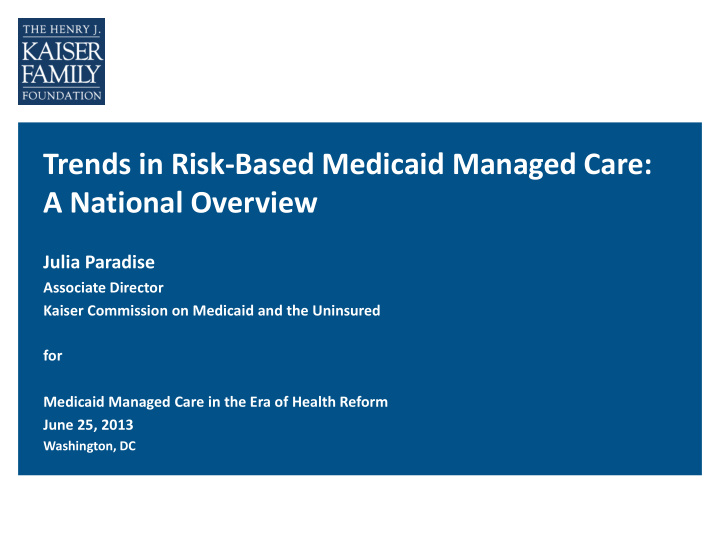



Trends in Risk-Based Medicaid Managed Care: A National Overview Julia Paradise Associate Director Kaiser Commission on Medicaid and the Uninsured for Medicaid Managed Care in the Era of Health Reform June 25, 2013 Washington, DC
Figure 1 Medicaid enrollment in comprehensive risk-based managed care has been climbing steadily. Number and share of Medicaid enrollees in 29.1m comprehensive risk-based managed care: 26.7m 23.5m 21.1m 20.1m 19.3m 18.9m 18.0m 51.0% 17.3m 48.9% 46.5% 45.1% 44.8% 42.3% 39.7% 40.5% 41.6% 2003 2004 2005 2006 2007 2008 2009 2010 2011 NOTE: Comprehensive risk-based managed care includes Health Insuring Organizations (HIO), comprehensive managed care organizations (MCO), and Program of All-Inclusive Care for the Elderly (PACE). Source: Medicaid Managed Care Enrollment Reports, 2003-2011, CMS.
Figure 2 In 26 states, over half of Medicaid beneficiaries are enrolled in comprehensive risk-based plans. Penetration of comprehensive risk-based managed care, July 1, 2011: VT WA ME MT ND NH MN MA OR NY WI SD ID MI RI CT WY PA NJ IA NE OH DE IN IL NV MD UT WV VA CO DC KS MO KY CA NC TN SC OK AR AZ NM GA AL MS LA TX FL AK 0% (14 states) 1-50% (11 states) HI 51-65% (10 states) U.S. Overall = 51% 66-80% (13 states, including DC) >80% (3 states) NOTE: Comprehensive risk-based managed care includes Health Insuring Organizations (HIOs), comprehensive managed care organizations (MCO), and Program of All-Inclusive Care for the Elderly (PACE). SOURCE: Medicaid Managed Care Enrollment Report, Summary Statistics as of July 1, 2011, CMS, 2012.
Figure 3 States are expanding their use of managed care in Medicaid through a range of actions. FY 2011 FY 2012 Adopted FY 2013 Number of states taking action: 35 23 20 17 15 14 14 13 12 10 10 9 8 6 5 5 4 Any of these Expanded Service Added Eligibility Added Mandatory Managed Long- Quality Initiatives Changes Areas Groups Enrollment Term Care or Major Contract Changes NOTE: States were asked to report new initiatives or expansions in these areas; the data do not reflect ongoing state efforts in these areas. While states have reported managed care quality initiatives in the past, there was not a comparable count available for FY 2011. SOURCE: KCMU survey of Medicaid officials in 50 states and DC conducted by Health Management Associates, October 2011 and 2012.
Figure 4 Medicaid expansion and delivery/payment system reform activity signal a larger role for managed care for high-need populations. • States are expected to rely primarily on MCOs to serve the millions of uninsured adults <139% FPL who will gain Medicaid coverage under the ACA. – Many are in fair or poor health, have multiple chronic conditions, and/or have a mental illness or substance use disorder. – 40% are extremely poor, more than 1/4 did not complete high school; many have no experience using health insurance or managed care systems. • Both states and MCOs are implementing initiatives to better coordinate and integrate care, often focused on populations with chronic and complex conditions and disabilities. • Increasingly, states are expanding risk-based managed care to include dual eligible beneficiaries, the frailest and most medically complex population in Medicaid. – Almost 1.2 million dual eligible beneficiaries in 33 states – about 13% of all dual eligible beneficiaries – are enrolled in these plans for their Medicaid services. – State demonstrations to integrate care and align Medicare and Medicaid financing for dual eligibles may include as many as 2 million of these ~ 9.2 million seniors and younger people with disabilities; most of the 21 state proposals employ a capitated model. SOURCE: Data on characteristics of uninsured adults <139% FPL from Coughlin T et al. What Difference Does Medicaid Make? Assessing Cost Effectiveness, Access, and Financial Protection under Medicaid for Low-Income Adults , KCMU, May 2013.
Recommend
More recommend